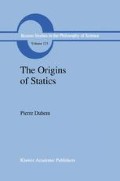Abstract
It is easier to resolve the question of perpetual motion in dynamics than in statics. However, for Leonardo da Vinci and for Cardan as well as for Aristotle, there are no insurmountable barriers between these two sciences. On the other hand, Galileo and Stevin accepted the impossibility of perpetual motion as an axiom capable of providing a basis for certain demonstrations in statics. And both of them had read Cardan, where they probably found support for their confidence in this axiom. But Cardan himself, in writing against perpetual motion, had done nothing more than summarize the scattered notes of Leonardo da Vinci. Thus we cannot gain a clear and complete picture of the origins of statics without reviewing the objections raised by Leonardo da Vinci and Cardan to the perpetuum mobile.
Access this chapter
Tax calculation will be finalised at checkout
Purchases are for personal use only
Preview
Unable to display preview. Download preview PDF.
References
T. N.: Leibnitz called the product of mass by velocity squared (mv2) the living force. This quantity is identical to kinetic energy except for the factor 1/2.
Les Manuscrits de Léonard de Vinci, published by Ch.Ravaisson-Mollien, Ms. A of the Bibliothèque de l’Institut, folio 21, verso. Paris, 1881.
T. N.: The Latin reads, “No violent motion can be perpetual.”
Les Manuscrits de Léonard de Vinci, published by Ch. Ravaisson-Mollien, Ms. A of the Bibliothèque de l’Institut, folio 34, verso. Paris, 1881.
Les Manuscrits de Léonard de Vinci, published by Ch. Ravaisson-Mollien, Ms. A of the Bibliothèque de l’Institut, folio 35, verso. Paris, 1881.
Here, too, Leonardo only develops what was taught in the School. “Motus simplex terminatur ad quietem,” (T. N.: The Latin reads, “Simple motion ends in rest.”) was the saying in the School.
Les Manuscrits de Léonard de Vinci, published by Ch. Ravaisson-Mollien, Ms. E of the Bibliothèque de l’Institut, folio 20, recto. Paris, 1888. Cf. Ms. E, folio 58, verso.; Ms. G, folio 81, recto., and folio 82, recto. Paris, 1890.
Les Manuscrits de Léonard de Vinci, published by Ch. Ravaisson-Mollien, Ms. A of the Bibliothèque de l’Institut, folio 22, verso. Paris, 1881.
Les Manuscrits de Léonard de Vinci, published by Ch. Ravaisson-Mollien, Ms. E of the Bibliothèque de l’Institut, folio 21, recto. Paris, 1888.
Les Manuscrits de Léonard de Vinci, published by Ch. Ravaisson-Mollien, Ms. A of the Bibliothèque de l’Institut, folio 22, verso. Paris, 1881.
Les Manuscrits de Léonard de Vinci, published by Ch. Ravaisson-Mollien, Ms. A of the Bibliothèque de l’Institut, folio 22, verso. Paris, 1881.
Cardan, Les Livres de la Subtilité, translated from Latin into French by Richard Le Blanc, Paris, l’Angelier, 1556, p. 339. The quotes which follow have been translated directly from the Latin text and are not from Richard Le Blanc’s translation which proves to be very obscure in this passage.
It should be pointed out that Cardan avoids deciding whether perpetual motion could possibly be produced with the help of a magnet. In Cardan’s time, the very strange properties of magnets preoccupied to a unique degree all those hoping to create a perpetuum mobile. In 1558, Achilles Grasser used one of the numerous manuscript copies in circulation among physicists to print for the first time in Augsburg the famous document written by Pierre de Maricourt (Petrus Peregrinus) in Charles of Anjou’s camp before the battle of Lucera on August 8, 1269. In his essay (a), Pierre de Maricourt, after having established the laws of magnetic actions in the fashion of the true logician versed in experimental methods, attempts to produce a perpetuum mobile with the aid of magnets.
Petri Peregrini Maricurtensis, De magnete, seu rota perepetui mobilis libellus. Divi Ferdinandi Rhomanorum imperatoris auspicio per Achillem P. Grasserum L. num primum promulgatus Augsburgi in Suevis, Anno Salutis 1558. (T. N.: Pierre de Maricourt, Manual on the Magnet, or the Wheel of Perpetual Motion, first printed in Augsburg, Swabia by Achilles Grasser in the year of our salvation 1558, under the auspices of the divine Roman Emperor Ferdinand.) This work has been reprinted in, Neudrücke von Schriften und Karten über Meterologie und Erdmagnetismus, edited by G. Hellman. No. 10, Rara Magnetica, Berlin, 1896.
Les Manuscrits de Léonard de Vinci, published by Ch. Ravaisson-Mollien, Ms. A of the Bibliothèque de l’Institut, folio 35, recto. Paris, 1881.
Les Manuscrits de Léonard de Vinci, published by Ch. Ravaisson-Mollien, Ms. C of the Bibliothèque de l’Institut, folio 6, verso. Paris, 1888.
Les Manuscrits de Léonard de Vinci, published by Ch. Ravaisson-Mollien, Ms. F of the Bibliothèque de l’Institut, folio 27, recto; folio 26, verso, and folio 30, verso. Paris, 1889.
Cardan, Les Livres de la Subtilité translated from Latin to French by Richard Le Blanc, Paris, l’Angelier, 1556, pp. 12 and 13. — This passage is not in the first edition of the De Subtilitate but it was added in the second edition.
Les Manuscrits de Léonard de Vinci, published by Ch. Ravaisson-Mollien, Ms. F of the Bibliothèque de l’Institut, folio 84, recto. Paris, 1889.
Rights and permissions
Copyright information
© 1991 Springer Science+Business Media Dordrecht
About this chapter
Cite this chapter
Duhem, P. (1991). The Impossibility of Perpetual Motion. In: The Origins of Statics. Boston Studies in the Philosophy of Science, vol 123. Springer, Dordrecht. https://doi.org/10.1007/978-94-011-3730-0_4
Download citation
DOI: https://doi.org/10.1007/978-94-011-3730-0_4
Publisher Name: Springer, Dordrecht
Print ISBN: 978-94-010-5658-8
Online ISBN: 978-94-011-3730-0
eBook Packages: Springer Book Archive

